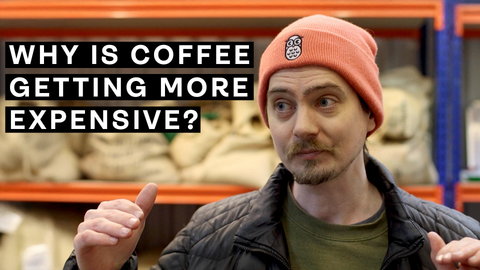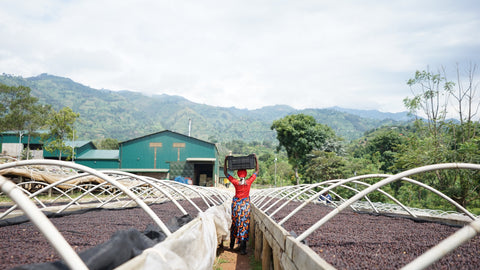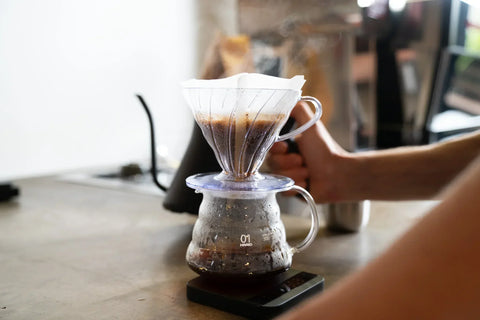
Let’s talk about the coffee market because currently, it’s gone...
Crazy.
You can watch Zach's YouTube video on this here, other read on.
So, to give a bit of context to this, I’m trying to make this video in light of how the coffee market has behaved over the last few months—particularly the last few weeks, actually. But also because there’s been a lot of conversation in the coffee industry about how the coffee market is moving, and there’s a lot of fear and uncertainty within coffee professionals, from coffee roasters, exporters, importers, and the producing side as well.
But there hasn’t been much conversation from our end—kind of the roasting side—to the end consumer side. And before we start seeing lots of stuff going out on major media (which I’m sure will happen eventually), I kind of wanted to spark some kind of conversation because we are now at a point in our own company where we’re having to put our prices up—to our wholesale partners and our online customers—from the start of March.
What’s Happening in the Coffee Market?
So, what has happened since last January? There were some effects of climate change—lots of frost in Brazil happened. There were also droughts and other climate change-related issues affecting some of the major coffee-growing regions around the world.
And particularly in Brazil. Brazil is one of the largest producers of coffee in the world—over 60% of Arabica is produced in Brazil. And that then leads on to coffee market speculation saying, “Okay, so there’s going to be less Arabica coffee available.” Basic supply and demand.
Now, the bit that gets confusing—what a lot of people don’t understand or don’t know (because why would you know unless you’re in the industry?)—is that all coffee, regardless of whether it’s specialty coffee or commodity coffee, is traded off the commodity stock market.
You have London Robusta and New York Arabica. Obviously, London is priced in pounds, and that’s pounds per metric ton (Great British Pounds). And in New York, it’s priced in dollars per pound (weight). Just to clarify—because it still confuses me sometimes!—2.2 lbs is 1 kilo for those of us in Europe.
Breaking Down the Coffee Commodity Market
To help you understand what’s going on, let’s start with what commodity coffee is. Not in terms of “what is specialty versus commodity,” but how coffee is traded on a commodity stock market.
Coffee is an agricultural crop that is traded like any other commodity—just like oil, gold, or gas—on the stock market. There's supply and demand, hedging, speculation... lots of things that I don’t properly understand, and there are smarter people who do.
I’m just trying to give a “Explain it like I’m five” type of understanding. If you want a more in-depth conversation on how stock markets work, I recommend a podcast with Stuart Ritson on The Coffee Knowledge Podcast. Very worthwhile listening if you want to know more about how commodity markets—especially coffee—work.
So, we’ve got this commodity stock market in New York that trades coffee. And there’s a base price that is set, which is built on supply, demand, and speculation.
When traders sell coffee to the market, there are other traders buying it for X amount.
How Market Speculation Affects Coffee Prices
When we start hearing news about climate change effects—like droughts and frosts in Brazil, or issues in Vietnam (which grows most of the world’s Robusta), speculation starts:
- “There’s going to be less coffee yield.”
- “There’s not going to be as much supply.”
Then we also have geopolitical issues—civil wars, wars affecting trading routes, and foreign exchange fluctuations.
For example, the New York market is priced in dollars—so the foreign exchange rate (USD to EUR, GBP, or COP for Colombia) also affects exports and imports.
So all of this stuff is going on. And basically, since January 2023, when there were reports of frost in Brazil, prices started rising.
And now, at the time of recording, the price has just dipped back under 420 cents per pound. It might be 427 cents per pound.
Yesterday, it actually broke 430 cents.
So when I say 430 cents per pound, that means $9 per kilo of coffee.
This sets the baseline price of coffee—not specialty coffee, just average coffee.
The Impact on Specialty Coffee
The commodity stock market acts as the baseline pricing for all coffee.
In the world of specialty coffee, there are usually premiums added to this baseline price. That’s why specialty coffee has always been more expensive than commodity coffee.
But now we’re at a point where $9 per kilo is the base price.
So what’s the incentive for a producer to keep growing specialty coffee if their cost of production hasn’t increased at the same rate?
If it costs them more effort and money to produce specialty coffee but they only get a slightly higher price, we might not see as much specialty coffee in the future.
How Roasters Are Handling This
There’s also fear and uncertainty from the trading side.
For example, I’ve been talking to our friends in Colombia, and they don’t hedge all their coffee.
They buy at the base price and then add premiums.
But if they buy at this high price and then the market crashes, they’ll be stuck with very expensive stock that’s hard to sell.
How We’re Managing It at Our Roastery
As a business, we’ve been fortunate—at least for 2025.
I saw the market going up, so I bought a lot of forward-contracted coffee at a decent price.
Then, as prices started rising even more, I contracted another batch.
So, we’ve averaged out our costs and will only be increasing prices by about 15% from March 1st.
I know many smaller roasters will struggle, as they don’t have the ability to forward-contract.
If you’re buying spot coffee (coffee that’s available off-the-shelf), prices have more than doubled since last year.
For example, a coffee we bought for X price last year is now 2X.
What’s Next?
Is there good news?
Well, if prices stabilize, the market should come down eventually—probably in 2026.
A lot of people speculate that by the end of 2026, we’ll see coffee prices return to around $2 per pound, which is more manageable for roasters and better for producers.
But in the long term, coffee has been undervalued for a long time.
It’s an exotic fruit seed—the amount of work that goes into growing and processing it is insane.
If coffee prices stay high, producers will have better lives, we’ll see higher quality coffee, and specialty coffee will become even more valuable.
Consumers will just have to get used to paying more for a cup of coffee.









